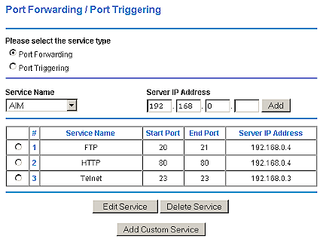Hardware Router Need To Know 2006
Everyone with a high-speed Internet connection needs a router. So why not learn how to choose the one that best meets your needs? We've updated and expanded our classic Hardware Router Need To Know to help you do just that!
Port Mapping (Forwarding, Virtual Server)
This feature goes by many names, but they all allow you to open holes (ports) in your firewall. You'll need to do this for most any Internet applications that depend on the ability of someone on the WAN (Internet) side of your router to send a data request to a computer on your LAN.
There are a few ways that manufacturers implement port mapping, and what you need will depend on what sort of applications you use. Let's take a look at the different types of port mapping features.

Static Single Ports
Figure 4 shows an example of the simplest form of port mapping. You must map each port used by an application to the IP address of the computer that the application is running on. Some routers allow you to specify either the protocol used for the mapping (TCP or UDP). Others automatically map the port for both protocols.

Figure 4: Port Forwarding Example

If you have only a few applications and they use only one or two ports each (i.e. running a web or FTP server) this method should be fine. Although the number of single port maps vary from manufacturer to manufacturer, you'll typically get somewhere around ten mappings.
Static Port Ranges
Sign up to get the BEST of Tom’s Guide direct to your inbox.
Upgrade your life with a daily dose of the biggest tech news, lifestyle hacks and our curated analysis. Be the first to know about cutting-edge gadgets and the hottest deals.
Similar to single port mapping, this option lets you map a range of ports in each mapping. Each mapping still applies to only one IP address, however. This option gives you the ability to handle applications that use a lot of ports such as games and audio/video conferencing. Again, the number of mappings varies from product to product, with ten or so being typically offered.
Current page: Port Mapping (Forwarding, Virtual Server)
Prev Page DHCP Server Next Page Dynamic ("Triggered") MappingTom's Guide upgrades your life by helping you decide what products to buy, finding the best deals and showing you how to get the most out of them and solving problems as they arise. Tom's Guide is here to help you accomplish your goals, find great products without the hassle, get the best deals, discover things others don’t want you to know and save time when problems arise. Visit the About Tom's Guide page for more information and to find out how we test products.
